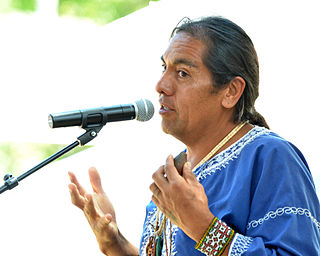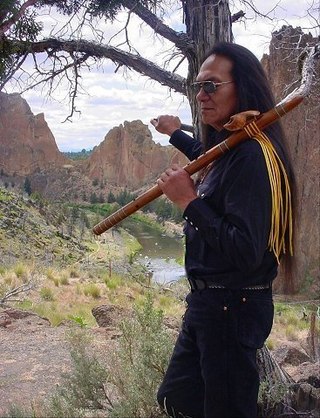Related Research Articles
Indigenous music of Canada encompasses a wide variety of musical genres created by Aboriginal Canadians. Before European settlers came to what is now Canada, the region was occupied by many First Nations, including the West Coast Salish and Haida, the centrally located Iroquois, Blackfoot and Huron, the Dene to the North, and the Innu and Mi'kmaq in the East and the Cree in the North. Each of the indigenous communities had their own unique musical traditions. Chanting – singing is widely popular and most use a variety of musical instruments.
Kiowa music is the music of the Kiowa Tribe of Oklahoma. The Kiowa are a federally recognized tribe, meaning they have a functioning government-to-government relationship with the United States government.
Jerod Impichchaachaaha' Tate is a Chickasaw classical composer and pianist. His compositions are inspired by North American Indian history, culture and ethos.

Gary Paul Davis, better known professionally as Litefoot, is a Native American rapper, actor, and businessman. He is the Executive Director of the Native American Financial Services Association (NAFSA), CEO of Davis Strategy Group and a member of the Forbes Finance Council. As an actor, he is known for his roles as Little Bear in the movie The Indian in the Cupboard, and Nightwolf in Mortal Kombat Annihilation.

Raymond Carlos Nakai is a Native American flutist of Navajo and Ute heritage. Nakai played brass instruments in high school and college, and auditioned for the Armed Forces School of Music after a two-year period in the United States Navy. He began playing a traditional Native American cedar flute after an accident left him unable to play the trumpet. Largely self-taught, he released his first album Changes in 1983, and afterward signed a contract with Canyon Records, who produced more than thirty of his albums in subsequent years. His music prominently features original compositions for the flute inspired by traditional Native American melodies. Nakai has collaborated with musicians William Eaton, Peter Kater, Philip Glass, Nawang Khechog, Paul Horn, and Keola Beamer. He has received 11 Grammy Award nominations for his albums.

The Native American Music Awards are an awards program presented annually by Elbel Productions, Inc., The Native American Music Awards Inc., and The Native American Music Association, a 501(c)(3) non-profit organization incorporated in 1998, which recognizes outstanding musical achievement in styles associated with Native Americans, predominantly in the United States and Canada.
Brulé & AIRO is a contemporary Native American new-age/worldbeat music group based in South Dakota. They have sold over one million CDs worldwide, won a number of awards, and have made media appearances with the Live with Regis and Kathie Lee television show, CNN WorldBeat, QVC, and others. They maintain a schedule of well over 100 performances a year including full stage productions with traditional dancers, an annual holiday tour, performances at Milwaukee's Indian Summer Festival, Indian Art Markets in Denver, Arlington (Tx.), and Overland Park, Kansas, Harbor Fest in Virginia Beach, the world-renowned Ordway Theater in St. Paul, Foxwoods Casino, and many additional outdoor festivals and events. They have released 22 CDs over their 21-year existence.
Andrew Jacob Vasquez is a Native American flute player of the Apache Tribe of Oklahoma. He has released four albums to date, Vasquez, the award-winning Wind River, V3: An American Indian, and Togo, all released by Makoché Records.

Robert Mirabal is a Pueblo musician and Native American flute player and maker from Taos Pueblo, New Mexico.
Joseph Fire Crow was a Cheyenne flutist. He released albums from 1992 to 2017. His album Cheyenne Nation was nominated for a Grammy in 2001. Fire Crow appeared many times as a guest musician on recordings by other musicians in the industry.

Joy Harjo is an American poet, musician, playwright, and author. She served as the 23rd United States Poet Laureate, the first Native American to hold that honor. She was also only the second Poet Laureate Consultant in Poetry to have served three terms. Harjo is a citizen of the Muscogee Nation and belongs to Oce Vpofv. She is an important figure in the second wave of the literary Native American Renaissance of the late 20th century. She studied at the Institute of American Indian Arts, completed her undergraduate degree at University of New Mexico in 1976, and earned an MFA degree at the University of Iowa in its creative writing program.

Bryan Akipa is a Dakota flautist with five solo albums to date.

Tommy Wildcat is a Native American musician and academic.
Walela is a trio of singers, named for the Cherokee word for hummingbird. The group was founded in 1996 by sisters Rita Coolidge and Priscilla Coolidge, with Priscilla's daughter Laura Satterfield as the third member.

Charles Littleleaf, a Native American flute player and flute maker, is a tribal citizen of the Warm Springs Indian Reservation, Oregon. Charles is also an honorary member of the Piikani Nation, Alberta, Canada, and is the son of the late Chief Jack Littleleaf of Brocket, Alberta.
Cecil Dick, or Degadoga (1915–1992) was a well-known Cherokee artist often referred to as "the Father of Cherokee Traditional Art."
The Bacone school or Bacone style of painting, drawing, and printmaking is a Native American intertribal "Flatstyle" art movement, primarily from the mid-20th century in Eastern Oklahoma and named for Bacone College. This art movement bridges historical, tribally-specific pictorial painting and carving practices towards an intertribal Modernist style of easel painting. This style is also influenced by the art programs of Chilocco Indian School, north of Ponca City, Oklahoma, and Haskell Indian Industrial Training Institute, in Lawrence, Kansas and features a mix of Southeastern, Prairie, and Central Plains tribes.
Jeff Carpenter is a musician and songwriter with the all Native American orchestral rock band Injunuity.
Jerry Chris Elliott High Eagle is a physicist and was one of the first Native Americans who worked at NASA. Elliott's work awarded him the Presidential Medal of Freedom, the highest civilian honor awarded by the President of the United States.
Joyce Lee "Doc" Tate Nevaquaya was a Comanche flute player and painter from Apache, Oklahoma. He is known for his contribution to the Native American flute music. His efforts in learning how to make Comanche flutes and play as well as compose contemporary Comanche flute music is considered to have saved the declining art from being lost completely. However, he said he considered himself a painter first, and painting was his primary art throughout his life.